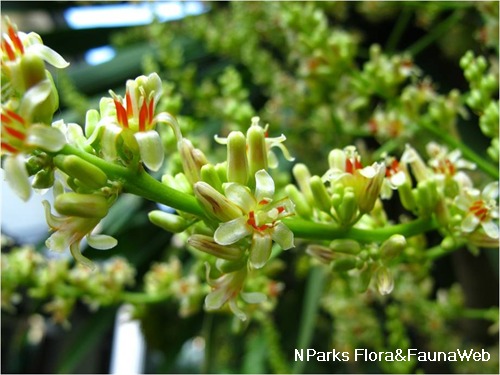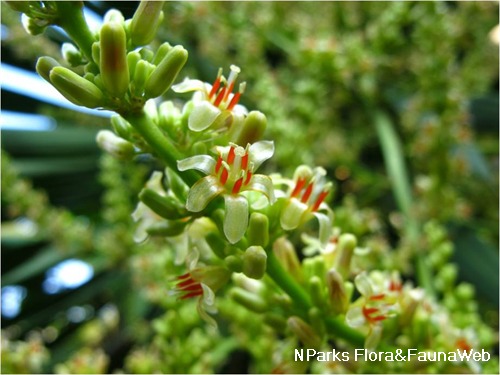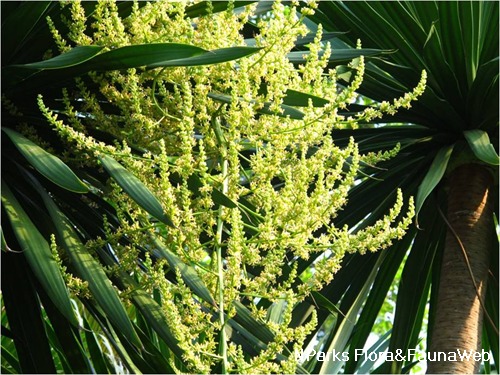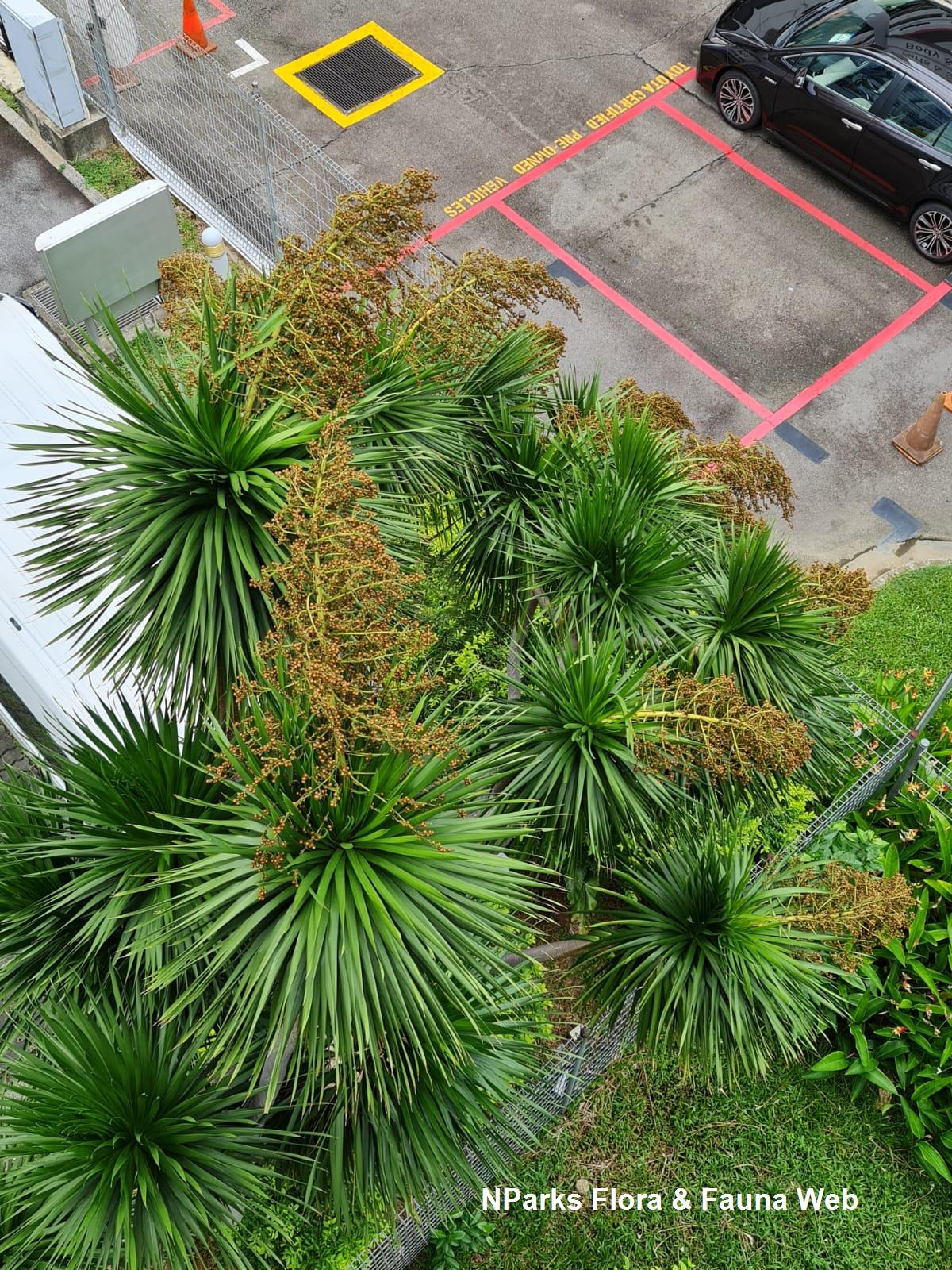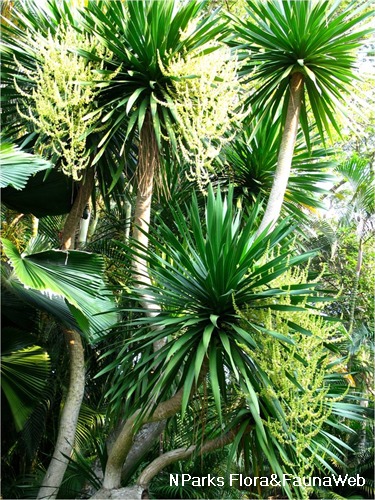
Back
Dracaena cochinchinensis (Loureiro) S. C. Chen in F. T. Wang & Tang
| Family Name: | Asparagaceae |
| Synonyms: | Dracaena loureiroi |
| Common Name: | Dragon Blood Tree, 剑叶龙血树 |
Name
Classifications and Characteristics
| Plant Division | Angiosperms (Flowering Seed Plants) (Monocotyledon) |
|---|---|
| Plant Growth Form | Shrub |
| Lifespan (in Singapore) | Perennial |
| Mode of Nutrition | Autotrophic |
| Plant Shape | Irregular |
| Maximum Height | 5 m to 15 m |
Biogeography
| Native Distribution | China, Cambodia and Vietnam |
|---|---|
| Native Habitat | Terrestrial (Inland Cliff) |
| Preferred Climate Zone | Sub-Tropical / Monsoonal |
| Local Conservation Status | Non-native (Horticultural / Cultivated Only) |
Description and Ethnobotany
| Growth Form | It is large, branched, tree-like shrub, from 5-15 m tall. |
|---|---|
| Foliage | The leaves are lanceolate, stalkless and crowded at the tip of the branches. Each leaf is 30-100 cm long and 2-5 cm wide, leathery and reddish at the base. |
| Stems | The stems are branched, growing up to 1 m in girth. The bark is smooth, greyish white, gradually becoming greyish brown over time. |
| Flowers | The stalked flowers are milky white, about 1.2-1.6 cm wide. The filaments (stalk below the stamen) are reddish brown and flattened. The flowers are in clusters of 2-5, borne on a branched, terminal inflorescence. |
| Fruit | The fruits are 1-3 seeded, almost round berries, 0.8-1.2 cm wide, ripening orange. |
| Habitat | It is grows on limestone slopes, up to 1,700 m. |
| Associated Fauna | The flowers are pollinated by insects. The ripe fruits are eaten by birds. |
| Cultivation | It can be propagated by seed. |
| Etymology | Greek dracaena, a dragon, referring to the bright red dried red resin, called dragon’s blood, obtained from various species including those of Dracaena. Latin cochinchinensis, from Vietnam, referring to one locality in the natural distribution of this species. |
Landscaping Features
| Landscaping | It is suitable for planting in parks and gardens for its ornamental form and spectacular flowers. |
|---|---|
| Desirable Plant Features | Ornamental Foliage, Ornamental Flowers |
| Landscape Uses | General, Parks & Gardens, Small Gardens, Focal Plant |
Fauna, Pollination and Dispersal
| Fauna Pollination Dispersal Associated Fauna | Bird-Attracting |
|---|---|
| Pollination Method(s) | Biotic (Fauna) |
| Seed or Spore Dispersal | Biotic (Fauna) |
Plant Care and Propagation
| Light Preference | Semi-Shade, Full Sun |
|---|---|
| Water Preference | Moderate Water |
| Rootzone Tolerance | Moist Soils, Well-Drained Soils, Fertile Loamy Soils |
| Propagation Method | Seed |
Foliar
| Foliage Retention | Evergreen |
|---|---|
| Mature Foliage Colour(s) | Green |
| Mature Foliage Texture(s) | Leathery |
| Foliar Type | Simple / Unifoliate |
| Foliar Arrangement Along Stem | Rosulate / Rosette |
| Foliar Shape(s) | Non-Palm Foliage |
| Foliar Venation | Parallel |
| Foliar Margin | Entire |
| Foliar Apex - Tip | Acute |
| Leaf Area Index (LAI) for Green Plot Ratio | 3.5 (Shrub & Groundcover - Monocot) |
Floral (Angiosperm)
| Flower & Plant Sexuality | Bisexual Flowers |
| Flower Colour(s) | Cream / Off-White |
|---|---|
| Flower Grouping | Cluster / Inflorescence |
| Flower Location | Terminal |
| Flower Symmetry | Radial |
| Inflorescence Type | Panicle |
Fruit, Seed and Spore
| Mature Fruit Colour(s) | Orange |
|---|---|
| Mature Fruit Texture(s) | Glossy / Shiny |
| Fruit Classification | Simple Fruit |
| Fruit Type |
Image Repository
Others
| Master ID | 662 |
|---|---|
| Species ID | 1957 |
| Flora Disclaimer | The information in this website has been compiled from reliable sources, such as reference works on medicinal plants. It is not a substitute for medical advice or treatment and NParks does not purport to provide any medical advice. Readers should always consult his/her physician before using or consuming a plant for medicinal purposes. |




